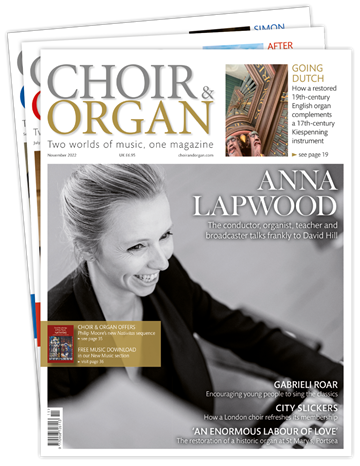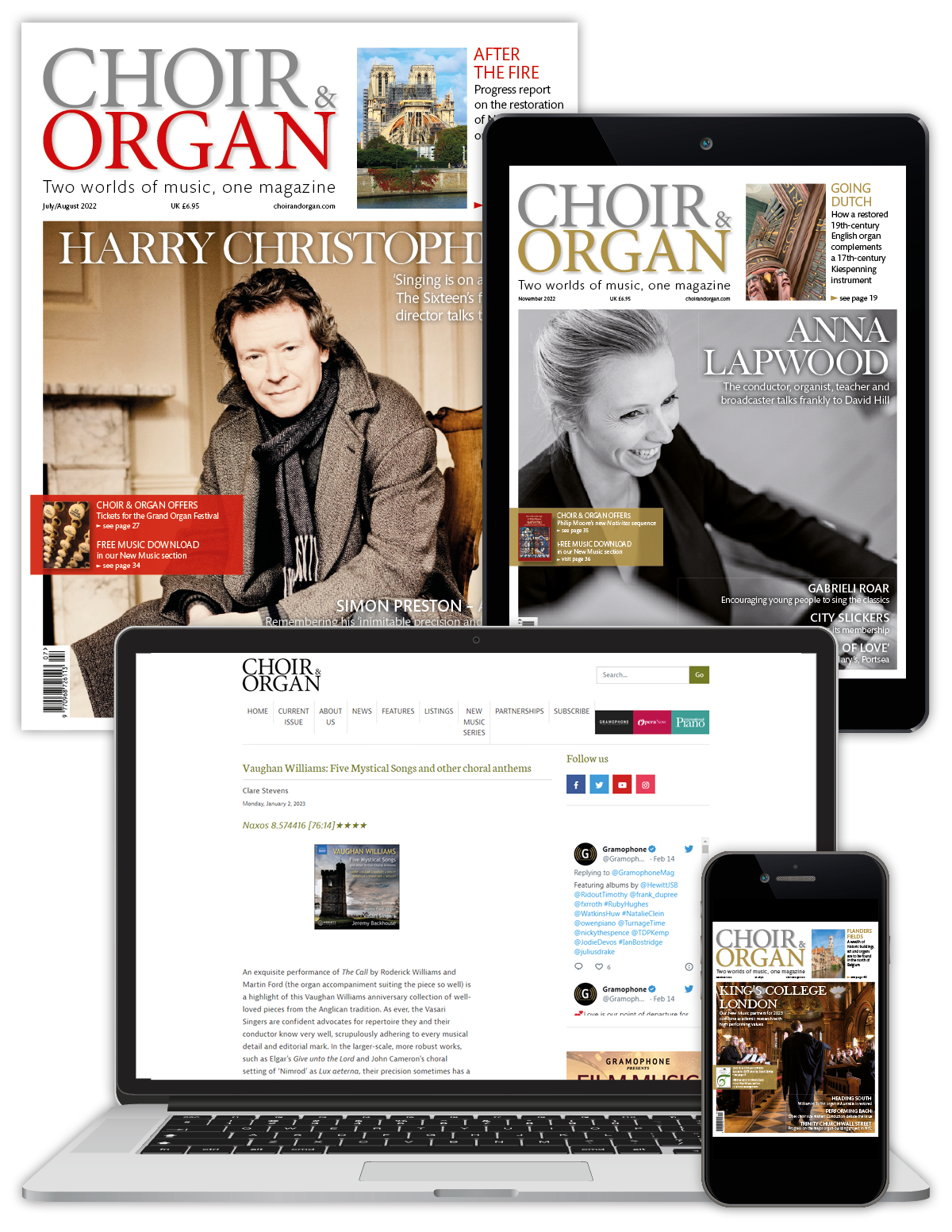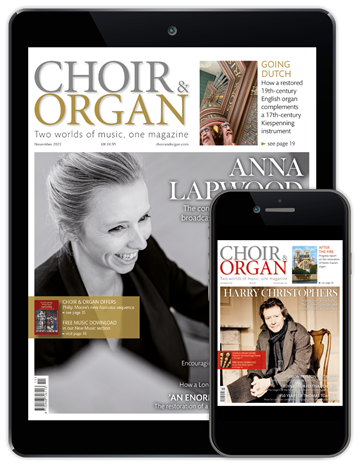Meeting Sander Booij, one of the most gifted Dutch organ builders of his generation
Chris Bragg
Friday, February 23, 2024
Chris Bragg meets Sander Booij, one of the most gifted Dutch organ builders of his generation, as he takes over the leadership of one of the country’s most venerable workshops

‘The careers advisor came to school and asked me what I wanted to become. When I told him that I wanted to be an organ builder he wasn’t exactly enthusiastic.’
I’m sitting with Sander Booij, one of the most gifted representatives of the new generation of organ builders and ideas in the Netherlands. Our conversation wanders widely; Booij, amicable and intense, is exceptional company. His encyclopaedic knowledge of and extensive direct contact with historic organ building feeds, as is often the case with Dutch builders, strong ideas about sound aesthetics, restoration practices and the interface between the creation of instruments and the making of music.
Now in his mid-thirties, Booij already has more than 20 years of experience to call on. Despite the misgivings of his careers advisor, while still at high school he undertook a traineeship with Klop and later, as part of a qualification in furniture making in Amsterdam, an internship with Flentrop. ‘They were restoring the [1916] Oscar Walcker organ at Doesburg,’ recalls Booij. ‘I was involved in the removing and re-making of the pneumatic motors.’ At 17, he set himself up in business as an independent organ builder with a focus on tuning, maintenance, (re-)voicing, pipework repair and restoration, as well as the rehousing of redundant instruments. The business, which since 2018 has operated in close collaboration with ex-Van Eeken craftsman Martin Butter, remained active alongside Booij’s work for other builders including Adema and Steendam, and freelance work on behalf of builders including Mense Ruiter and even the UK-based Drake (on-site voicing work on the Swell at Chelsea Old Church). Although not professionally trained as a musician, Booij is also one of the most gifted organists one is likely to encounter among the organ-building fraternity, able to improvise complex chorale fantasias in the North German style with extraordinary flair, somewhat in the spirit of Sietze de Vries. He was one of the organists of the Grote Kerk in Wijk bij Duurstede, where he and his colleagues were responsible for leading the outstanding restoration and rehoming of the 1883 Harrison & Harrison organ from St Peter’s, Bishop Auckland, where it provides a noteworthy counterpoint to the church’s esteemed 1617 meantone organ by Albert Kiespenning [C&O Nov 2022, pp.19-22].
In 2020, Booij was appointed managing director of the Groningen workshop of Mense Ruiter, now located in the village of Ten Post. This company was founded by Ruiter (1908-93) in 1931, initially undertaking maintenance of existing instruments. During the 1940s, restoration projects were added to the portfolio and new organs were built from the 1950s onwards. Like their better-known Dutch contemporaries, these initial organs followed the dogmas of the era, largely determined by the Lambert Erné-led organ committee of the Dutch Reformed Church. Nevertheless, Ruiter was sufficiently headstrong to create organs which, while largely based on the Dutch/Danish organ-type, quickly absorbed elements of the historic organs of the north-east and which were a little less sharp in character. The 8ft Trompet, so often absent from the pedal departments of neo-Baroque organs, was, more often than not, present and correct.
A particularly fine example of the firm’s work is found in the 1950s Van der Kuilen/Trappenburg-designed Koningskerk in Amsterdam. In an imposing brutalist structure, Ruiter had sufficient freedom to design the unusually convincing ensemble of modernist cases himself. This instrument has just been overhauled, with changes made to the sound of the flues in the early 1990s largely reversed. ‘The sound was made milder by my predecessor Jan Veldkamp at the request of the organist,’ says Booij. ‘The flutes had had their cut-ups increased and some small nicking applied to the languids. I removed all the nicking (it was easy enough to see which was original and which wasn’t). In addition, I increased the toe openings a little to compensate for the cut-ups. The entire sound was revisited in minute detail. When Mense Ruiter was voicing the organ originally, he spent months perfecting the sound on-site and you could still hear this “in the distance”, as it were. We tried to bring this “perfection” back to the sound. We also re-introduced the silenced ranks in the Mixtuur and Scherp. Neo-Baroque organs often don’t become more beautiful when the sound is softened…’
On Ruiter’s retirement in 1974, Jan Holthuis took over the leadership of the business, from 1980 onwards alongside Jan Veldkamp. Like those of their peers, the organs, both visually and musically, became more historically aware; by 1981, the workshop was able to deliver a new organ (II/23) to ‘De Kandelaar’ in Assen, housed in a spectacular pair of richly-carved cases, the antithesis of the Amsterdam organ’s visual starkness. The historic influences developed further under the leadership, from 1990, of Dolf Tamminga.
A project undertaken early in Booij’s tenure has been the renovation of a Ruiter organ built in 1979 for the mid-1920s brick church in Kollumerzwaag (Friesland) and including a considerable body of 1950s pipework which Ruiter had added to its undistinguished Dekker pneumatic predecessor. The organ is located high above the pulpit on the east wall. ‘They wanted to build a Baroque organ but without the knowledge and the techniques to achieve it,’ notes Booij. Remarkably, when the builder’s good intentions saw the provision of a stack of three wedge bellows, located adjacent to the instrument, the congregation complained, and they were promptly replaced with an internal single reservoir, out of sight and out of mind.
The present renovation was primarily intended to overhaul an organ which, after 40 years, was showing its age and still had to accompany the singing of 150-200 people each Sunday. The organ was cleaned, tuning damage repaired and the keyboards restored. A recent church restoration, the ideal conditions for tonal work resulting from the Covid restrictions and the absence of a consultant, permitted seven weeks of re-voicing, however, and Booij has taken the opportunity to maximise the organ’s potential within the present technical limitations. ‘When the organ was built, there was no voicer involved; the pipes were all pre-voiced by Stinkens. Later, Jan Veldkamp was engaged and made some changes. There was a lot of nicking; I have tried to remove as much as I can, with the exception of some of the larger pipes.’ The narrow-scaled 1950s 3ft Spitsquint on the Hoofdwerk is a case in point; in addition to the removal of the nicking, certain cut-ups have been enlarged, and the languids raised to slow speech and to encourage overtones. It is now a lively, chameleon-like stop, binding the plenum, colouring the Trompet or taking on the role of soloist. The raising of the languids and the opening of the toes has been applied consistently across the fluework. The Pedaal Bourdon, made of copper, now sounds far broader and can be used for the first time with the 8ft Prestant alone, its cut-ups similarly raised. The interventions to the reeds have been even more drastic. The Hoofdwerk Trompet, for example, has had several of its tongues replaced with thicker examples and the trebles have been made stronger. The Dulciaan has had its shallots transposed and the tongue curvature changed throughout the compass. For this to occur, the tongues were first annealed to improve their pliability; a process used on many of the reed tongues elsewhere in the organ. In the Pedaal, several tongues were replaced with thicker ones, the shallots have been flattened and leather added in the North German manner in the upper part of the compass. The Trompet was a later addition and has now been revoiced, emerging warm, muffled and elegant.
In conjunction with improved acoustics brought about by a new, polished stone floor, Booij has succeeded in creating an organ full of tonal interest. The choruses are lively and slightly scratchy while wholly coalescent, the flutes likewise, with transient both present and pleasant; further evidence of the changing perceptions of the sound of historic and historically influenced flue choruses I have noted in several previous articles. The reeds are round, dark and fundamental-oriented, the Hoofdwerk Trompet and Pedaal Bazuin more Renaissance than high Baroque. Booij’s work in Kollumerzwaag is a notable achievement in the context of an organ built during an intermediate phase of Dutch organ building generally, and further compromised by the large quantity of earlier pipework of only moderate distinction. Indeed, even the cases, limited by the church’s height, in some way represent the crossroads of ideas; the Rugwerk with its obvious Hanseatic Renaissance flavour, the main case more obscure in its references, the Pedaal towers notwithstanding. The absence of a manual 16ft stop in an organ intended primarily for congregational singing further marks the instrument out as a child of its time. Nevertheless, the Mixtuur of the Hoofdwerk originally included a 51/3ft quint which has now been silenced.
Meanwhile, the first new organ to emanate from the Booij-led Ruiter workshop is well underway. Its predecessor in the Utrecht village of Renswoude was undistinguished, but it contained a body of older pipework from previous instruments which demanded attention, not least because it clearly exhibited Southern influences. Extensive research has established a number of 18th-century stops from an unknown maker, alongside beautiful 19th-century material, most likely by Johannes Vollebregt (1793-1872). Vollebregt was active primarily in Den Bosch and built technically traditional organs for the Catholic market in North Brabant (and further afield). Study of other Vollebregt organs has provided pointers for scaling, case and console design. The organ is due to be completed during 2024. As is often the case today with smaller builders in the Netherlands (Ruiter currently has six employees), ongoing collaborations are a feature of the workshop’s modus operandi, whether with pipe maker Stinkens, where Wijk bij Duurstede colleague Pim Schipper is a pipe maker and voicer, or with the Van Rossum organ-building workshop.
The changing of the guard at one of the Netherlands’ long-established, if less fashionable, workshops, located in the ‘organ garden of Europe’ as Groningen province is known, is intriguing, even in this challenging time for organ building generally. Such is Booij’s hunger for knowledge about organs of all sorts, the extent of his pre-occupation with questions of sound and the startling results of his voicing work so far, one would be unwise to ignore his and the Mense Ruiter workshop’s projects in the coming years.
Sander Booij is featured in GOArt’s YouTube video series ‘Organ Hunting in the Netherlands’
Chris Bragg studied organ at the former RSAMD and the Conservatories of Amsterdam and Utrecht. He is head of programming at the University of St Andrews Music Centre, artistic director of St Andrews Organ Week, and a freelance organist, teacher, writer and translator
This article originally appeared in the Spring 2024 issue of Choir & Organ magazine. Never miss an issue – subscribe today







